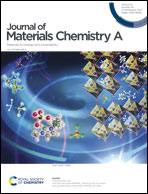In situ thermal exclusion induced Sb and Sb-doped SnO2 nanoheterostructuring and its improvements in cycling stabilities and rate capacities for Na+ storage†
Abstract
This work reports a novel in situ thermal exclusion approach for the synthesis of carbon coated Sb and Sb-doped SnO2 hetero-nanoparticles (Sb-ATO hetero-NPs) deposited on MWCNTs (C@Sb-ATO/MWCNTs) through the annealing of PPY@ATO/MWCNTs. Depending on the specific structural features of C@Sb-ATO/MWCNTs, which integrate the advantages of nanostructuring, elemental doping, heterostructuring, and carbon integration, C@Sb-ATO/MWCNTs shows improved performance for Na+ storage. Specifically, it exhibits a high reversible capacity (430.6 mA h g−1 at 0.1 A g−1), superior rate capabilities (198.5 mA h g−1 at 30.0 A g−1) and remarkable cycling stabilities (275.5 mA h g−1 at 5.0 A g−1 for up to 10 000 cycles). The Sb doping and Sb-ATO nanoheterostructuring are demonstrated to be the main origins of the high performance of C@Sb-ATO/MWCNTs. DFT calculations indicate that the Sb doping can increase the electrical conductivity of ATO and promote the diffusion and storage of Na+ ions in ATO, and the electrical conductivity of the Sb-ATO hetero-NPs can be further increased by the Sb-ATO heterostructuring. The result presented here indicates that the strategy in combination of nanostructuring, elemental doping, heterostructuring, and carbon integration is a promising way to obtain anode materials with high performance for Na+ storage.



 Please wait while we load your content...
Please wait while we load your content...